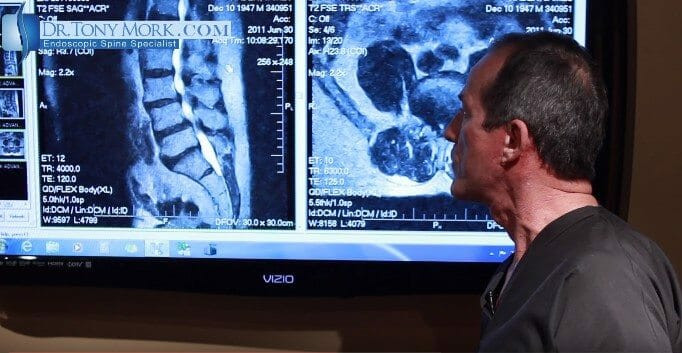Annular tear treatment is usually not prescribed by most doctors, being that they're so difficult to detect. Sometimes, patients go from one Doctor to another, seeking solutions to severe back or neck pain and never find an answer. The Doctors will probably conduct MRI scans and come up with nothing repeatedly. In most cases, this is typically indcative of an annular tear.
Dr. Tony Mork is an endoscopic spine surgeon who specializes in helping patients with back and neck pains, especially pains caused by Annular tears. He has developed unique diagnosis and treatment methods which allow him to provide relief for his patients back pain and in many cases has treated debillitating conditions that prevent patients from walking, standing, or sitting and performing the basic everyday functions.
What Are Annular Tears?
An annular tear is an injury in the spinal disc between the vertebrae of the spine. These spinal discs cushion the vertebrae, absorb shock, and help with the spine’s movement.
The disc comprises two parts; an inner part filled with jelly-like fluid, the nucleus, and an outer covering that wraps around the nucleus, the annulus. Any tear or crack in the annulus is known as an annular tear.
While most annular tears don’t hurt, some annular tears, known as toxic annular tears, do hurt. Patients who suffer from toxic annular tears experience acute pains in their neck, lower back, and tailbone regions and should be diagnosed and treated as soon as possible.
Can MRI Diagnose Annular Tears?
Most Doctors diagnose annular tears by utilizing MRI (magnetic resonance imaging) scans. However, MRI scans usually miss annular tears, especially if the tear is relatively small.
In some cases, MRI presents an annular tears as a disc bulge or a High-Intensity Zone. However, spine bulges are common in most adults above 40. Hence why tears in the annulus are usually overlooked.
Also, there is no correlation between a high-intensity zone and annular tears, so it gets overlooked too. Hence, MRIs are usually read as negative, making them unsuitable for diagnosing Annular Tears.
How Does Dr. Mork Evaluate Annular Tears?
While assessing annular tears, Dr. Mork considers the patient’s history. A spine bulge on the MRI scan might indicate annular tears when combined with the patient’s record.
Dr. Mork considers past events such as auto accidents, sports injury, improper lifting, and regularly sitting for too long when assessing Annular Tears.
Another step Dr. Mork might take is by injecting the painful disc with a dye, also know as a discogram and then performing a CT scan. The CT scan will show any of the dye leaking into the disc indicating an annular tear and it's specific location. Check further on in the article for more discussion on this process.
What are the Symptoms of Annular Tears?
Dr. Mork has categorized the usual pains experienced by patients suffering from toxic Annular Tears into what he called “The toxic 12” and added that a patient with at least two symptoms has a 90% chance of being diagnosed with toxic annular tears. The Toxic 12 are:
- Severe Back Pain
- Muscle Strain
- Pains and numbness in the genitals
- Severe leg pain even after a negative MRI
- Acute pain in the Groin
- Middle Back Pain
- Pains that become worse from physiotherapy
- Lower Back Pain
- Pain from sitting in the car
- Exercise pain
- Burning Pains in the leg
Toxic Annular Tears Diagnosis
Having discovered that MRI scans don’t diagnose toxic annular tears, Dr. Mork diagnoses his patients using a CT Discogram. A CT Discogram is a discogram followed by a CT scan.
In a CT Discogram procedure, A liquid dye is injected into the disc and observed in a CT scan. The color of the disc and the dye will be in contrast, making any annular tear, however small, visible.
Although this method is quite painful, it is a very effective way of diagnosing toxic annular tears.
How Are Annular Tears Treated?
There are several methods of treatment for annular tears. Some doctors leave it to heal by itself. However, due to the shortage of blood flow in the annulus fibrosis, with conventional treatments it usually takes up to 18 months to 2 years to recover.
Other doctors start with conservative treatments, prescribing anti-inflammatory or nerve pain medication to reduce pain. Other treatments such as massage and physical therapy, are also used to treat annular tears.
Dr. Mork treats annular tears using endoscopic spine surgery. Endoscopic spine surgery is a minimally invasive surgical procedure that effectively reduces chronic back pain. It's an out patient procedure and most are back on their feet the day of surgery and fully recovered within 1-6 weeks.
Endoscopic spine surgery allows the doctor to operate and monitor your spine through an HD camera attached to an endoscope. This procedure produces a more accurate result and requires a shorter recovery time.
Consult Dr. Tony Mork For All Sort of Back and Neck Pains
If you are experiencing severe back and neck pains, you should visit a specialist as soon as possible, as delaying treatment might lead to a more painful situation.
Dr. Tony Mork is a specialist in minimally invasive spine surgery for back and neck pains. He provides treatment for annular tears, disc herniations, spinal stenosis, and other neck and back diseases.
Call Dr. Tony Mork at 49-640-6674 or visit his website to book an appointment.
Read more on annular tears here: https://drtonymork.com/back-pain/annular-tear/annular-tears/































